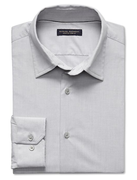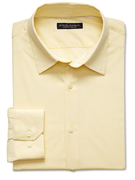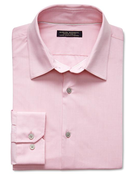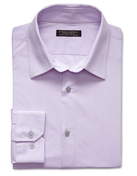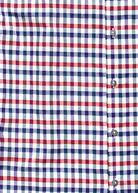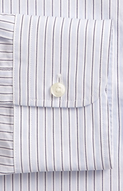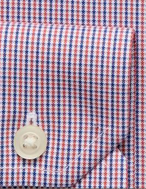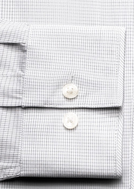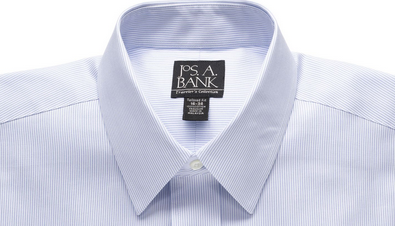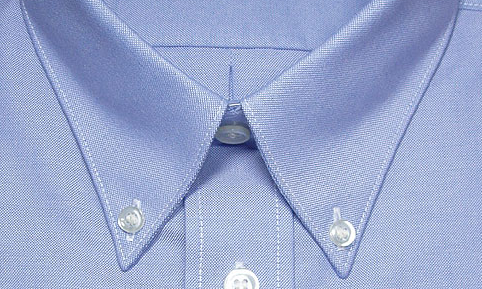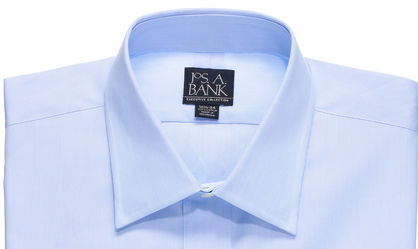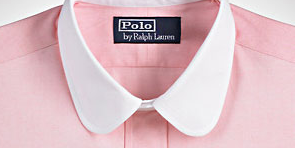the shirt
The suit might cover the most surface area on a guy, but the shirt is what really sets the tone of the outfit. In the past, ties used to get all the attention. Shirts now come in varieties that invite you to be creative with the rest of your outfit, especially considering it's what you see if the suit jacket comes off. You just have to know how to combine colors and patterns in a way that works, and that's what I'm here for.
Before I go into what could ultimately be an endless exploration of the world of button downs (don't worry, I'll control myself), there's one piece of advice I want to give. I have to admit the fact that though I'm about to endorse everything but the traditional dress shirt, before you can take those leaps, you need the foundation of a white and light blue traditional dress shirt. In reality, you should get two of each, but should you need to be more conservative, this is the only way to go. And as usual, make sure it fits. Shirts come in a lot of different fits, and too tight or too billowy is not the right fit for anyone.
Moving on. Let's start with color. Solid colors will get you very far, especially if your favorite tie is one that doesn't sit well with other patterns. Apart from the blue and white shirts every man should have, stick with solids in agreeable colors, usually ones on the lighter side. You don't want to appear to be cheering on your favorite school.
Before I go into what could ultimately be an endless exploration of the world of button downs (don't worry, I'll control myself), there's one piece of advice I want to give. I have to admit the fact that though I'm about to endorse everything but the traditional dress shirt, before you can take those leaps, you need the foundation of a white and light blue traditional dress shirt. In reality, you should get two of each, but should you need to be more conservative, this is the only way to go. And as usual, make sure it fits. Shirts come in a lot of different fits, and too tight or too billowy is not the right fit for anyone.
Moving on. Let's start with color. Solid colors will get you very far, especially if your favorite tie is one that doesn't sit well with other patterns. Apart from the blue and white shirts every man should have, stick with solids in agreeable colors, usually ones on the lighter side. You don't want to appear to be cheering on your favorite school.
These colors go well with any basic colored suit you should own, and even some non-traditional ones, like khaki. Patterns are where you get to have the most fun, but in a professional setting, you don't get to have too much fun. Stick to sophisticated patterns, again, in colors that can go with any suit and many tie options. The subtler, the better, but that doesn't mean you have to snooze over your choices.
Patterns can also add a lot of interest to your wardrobe and give you more options. Wearing patterns with a suit can often set you apart from other suit-wearers, especially if you expertly pattern mix with a tie or wear a well-matched solid tie. Like with solids, subtle is better, but because the color is less saturated on the shirt, you can incorporate bolder colors here with more condensed patterns. Patterns also add versatility and personality to your wardrobe when, after the interview, you don't always have to don the full suit or wear a tie.
Symmetrical patterns like checks, ginghams and stripes are going to be the most versatile. Other great patterns exist, but with more daring patterns, color is key--stick hues that will work well with many suit/tie combinations.
The last major aspect to consider is the collar. There are a lot of choices out there, but the most useful collar styles will be the straight collar and the semi-spread. Button collars are slightly less formal, but still work well with suits. Stay away from spread collars, unless you're going for an interview on Wall St. Thinner collars are becoming more popular with slim fit suits, but you have to make sure the proportions are right. GQ has a good guide for this relatively new trend here. And if you're really adventurous and going in for a more creative job, take a stab at the club collar, though that might be more for the first day on the job than for the interview.
straight/point collar, button collar, semi-spread collar, spread collar, club collar
A few final details: Don't forget about the option of a french cuff shirt. The french cuff shirt can be done well, but in this case make sure you have at least one good set of everyday cufflinks.
The shirt can be the focal point of the outfit because it offers the biggest opportunity to add interest to an ensemble. The range of acceptable dress shirts is vast, but if you find a good fit in a quality fabric, you're set for anything from a fully suited look to a shirt-and-khakis casual Friday. Just make sure you don't take the short sleeved button down dive. Interview or not, that's almost never okay.
Shirts: Banana Republic shirt in Grey, Grapefruit Yellow, Delicate Pink and Light Purple, Paul Smith, 1901, Banana Republic, Calvin Klein
-E
